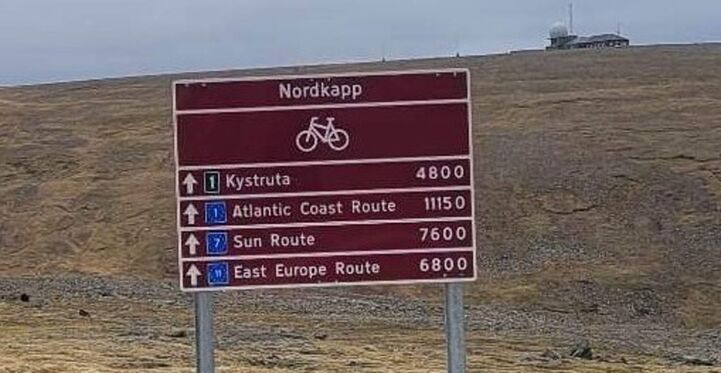Making headway: National EuroVelo Coordination Centres lead 2023 EuroVelo development
New and updated national websites about EuroVelo
This year saw an unprecedented number of national websites about EuroVelo and/or cycling tourism – totally new ones or revamped – finally going online. Generally, national information about EuroVelo is either included in a larger portal or can be found on an ad hoc website.
For the first category, we start up north, with CycleNorway.com, a website that includes various ways of exploring the country on a bicycle, including EuroVelo routes. Its creation is supported by the Norwegian Public Road Administration (Statens Vegvesen), which acts as the National EuroVelo Coordinator.
More news from Scandinavia: a section about EuroVelo was also included in the Finland Bikeland website, launched last year. Over in Denmark, the new ruter.dk website, by the NECC Danish Cycling Tourism, includes the eleven national long-distance cycle routes and the four EuroVelo routes crossing the country.

Over in Ireland, the extremely specific EuroVelo 1 website adds precise information about the Atlantic Coast Route and is conceived as part of the AtlanticOnBike project – read on to see how well Ireland is developing the longest route of the network!
SwitzerlandMobility, the Swiss NECC, launched this summer a top-notch, extremely detailed new website about Swiss routes – not only cycling routes, but also hiking, mountain biking, canoeing, skating, and winter sports. Planned improvements to the website include more specific information about EuroVelo, but the website sets the bar high when it comes to public transport integration, visitor information, and route planning (which is set as a subscriber-only feature).
On the business side, Fietsplatform, the Dutch NECC, launched a restyling of their logo and professional website, which is now strongly oriented on data to show the development of cycling tourism in the country.
More and more EuroVelo signage
In the EuroVelo Route Development Status Report 2023, based on 2022 data, we read that 37% of the network has EuroVelo signs in place, corresponding to more than 33,000 km, in 24 countries. In 2023, even more steps forward have been taken: around 1,000 km of EuroVelo routes have been signposted in Norway with EuroVelo 1, 7 and 11 signs, all the way to the North Cape. We must say that seeing a EuroVelo sign at the northernmost point of our network gave us chills!

Good news regarding signage also comes from Finland, with the signposting of EuroVelo 13 – Iron Curtain Trail in rural areas, and Spain, with the extension of EuroVelo 3 to Cape Finisterre in Galicia. Signposting of all EuroVelo routes in Germany is ongoing, as announced last year, and in Greece, more exciting developments are expected for 2024.
It happened quietly but it did not go unnoticed: 100% of the EuroVelo route kilometres in Estonia are now signposted with our beloved twelve-star signs. Quite an achievement for a country without a National EuroVelo Coordination Centre (yet) but with lots of cycling tourism potential!
Building infrastructure and routes
The Cycle Route of the Year is a EuroVelo route! EuroVelo 5 – Via Romea (Francigena) in Belgium was awarded this prestigious label during Fiets en Wandelbeurs in Utrecht last February. It is not the first time that a EuroVelo route has received this prize, but it is the first time that EuroVelo is in the marketed name. The award is an excellent recognition of the work that Pro Velo, the Belgian National EuroVelo Coordination Centre, has been doing, gathering lots of regional and local partners under the same umbrella and coordinating the promotion of EuroVelo in Belgium.

Moving north, EuroVelo 1 – Atlantic Coast Route in Ireland was finally formally inaugurated in the presence of the Minister of State at the Department of Transport, Jack Chambers. The route was signposted in its entirety as part of the AtlanticOnBike project, and it looks like one of the up-and-coming routes for the summer. Steps have been made in the development of EuroVelo 2 – Capitals Route, too, with the opening of a cycle and pedestrian bridge over the river Shannon in Athlone.
In Spain, EuroVelo 8 – Mediterranean Route is being constructed around Cadiz, while Hungary added no less than 400 route kilometres in the country, as the second stretch of EuroVelo 14 – Waters of Central Europe. The Hungarian capital of Budapest is now even more connected to the EuroVelo network, with the route ending in Debrecen. We have dedicated an extensive article to the Hungarian NECC success story.
Stronger and better together
The NECC network is a vibrant and active one. With the Centre for Environment being accepted as a National EuroVelo Coordinator for Bosnia and Herzegovina, there are now 24 NECCs all across Europe. The aim is to further increase this number in the coming years, as well as increase the number of Coordination Centres – ad hoc consortia gathering national stakeholders involved in the development and maintenance of EuroVelo routes.
The annual gathering of NECCs saw almost 60 people present – a record number! The future looks bright for the NECCs to expand and strengthen, also thanks to networking opportunities and the sharing of best practices in NECC workshops, at the EuroVelo Conference and more.

Article by Jessica Casagrande